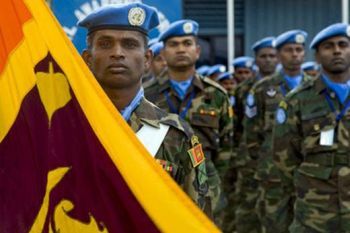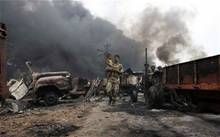
Publisher:
Bonnie King
CONTACT:
Newsroom@Salem-news.com
Advertising:
Adsales@Salem-news.com

~Truth~
~Justice~
~Peace~
TJP
Dec-02-2012 12:20

 TweetFollow @OregonNews
TweetFollow @OregonNews
Can the UN Learn From Its Own Grave Failures?
Salem-News.comThe Sri Lankan Civil War is one of several notable failings of the UN and in order to maintain any form of legitimacy the incidence of such shortcomings must decrease.
 Sri Lankan Army |
(COLOMBO) - In early November a damning internal United Nations report into the organisation’s actions at the end of the Sri Lankan Civil War was leaked. The document, in uncharacteristically unequivocal terms, stated that the UN had shown “a grave failure” in its mandate to protect the lives of civilians as the conflict trudged towards its appalling climax.
For more than a quarter of a century the island nation found itself crippled by war as the Tamil Tigers (LTTE) fought for independence in the north and east of the country. Over this 25-year period the war is estimated to have claimed far in excess of 100,000 lives and it is widely believed that the final death toll will significantly eclipse this. Some recent estimates suggest that as many as 50,000 people died in the final months of the war before the cessation of hostilities midway through May 2009.
"In spite of the self-deprecation of the UN, the underlying concerns of international human rights groups remain unanswered."
Since then human rights groups have highlighted accusations of crimes against humanity that occurred on both sides of the conflict. Both Amnesty International and Human Rights Watch have drawn attention to the aerial bombardment of hospitals by government forces and to the use of civilians as human shields by the LTTE. Such actions occurred in contravention of the laws of war, while a seemingly redundant United Nations failed to stop these tragedies. A well-publicised Channel 4 documentary entitled ‘Sri Lanka’s Killing Fields’ sought to raise public awareness of such issues drawing both praise and criticism for the manner in which it depicted executions and the shelling of supposed ‘safe zones’.

Yet in spite of the self-deprecation of the UN, the underlying concerns of international human rights groups remain unanswered. As Sri Lanka is not a signatory to the statute of the International Criminal Court it remains highly unlikely that any representatives of either of the combatants will be duly referred and therefore held accountable. Instead, the report has descended into the customary flurry of bickering, riposte and counter-riposte that has become all too synonymous with United Nations crises.
Instead of becoming a symbol of an organisation willing to learn, develop and improve as it faces future challenges, immediate responses were largely exercises of blame exoneration. Former humanitarian chief John Holmes pointed to the “difficult dilemmas” that the UN faced, arguing that the nature of the conflict was such that it would have been impossible for the situation to be ameliorated. Meanwhile the Sri Lankan government rejected the accusations of human rights abuses made in the report as both folly and unsubstantiated.
"With an abundance of crises currently unfolding around the globe the UN must seek a means of being able to effectively address the ensuing humanitarian challenges".
Whilst all these reactions are typical of the post-crisis rhetoric that tends to engulf the UN, the severity of the report was far less expected. The report lays bare the fundamental flaws of an organisation that seeks to offer hope in conflict situations but all too often finds itself rendered redundant. It suggests that the UN not only failed in its duty to protect civilians from the perils of conflicts but that there were also “systematic” failures in the organisation of UN operations in Sri Lanka.
All of this has wide-reaching consequences for the future. With an abundance of crises currently unfolding around the globe the UN must seek a means of being able to effectively address the ensuing humanitarian challenges. As conflicts such as those currently on view in Syria and the Democratic Republic of the Congo continue to manifest, the organisation requires a method of learning from the lessons of past failures. A key part of this is its capacity to adapt, both on a practical and policy level. There are merits to publishing a scathing report, however, if this descends into the usual games of blame and denial, long-term progress will become blurred with political gesturing.
The Sri Lankan Civil War is one of several notable failings of the UN and in order to maintain any form of legitimacy the incidence of such shortcomings must decrease. The primary obstacle to this is that it will also be constantly restricted by the power of its member states. In the absence of an army, the UN will ultimately be powerless to stop such atrocities. Similarly in the absence of universal legal authority no action can be taken against a multitude of war criminals. Evidently the establishment of either of these are beyond the realms of possibility and consequently the UN is forced to operate in a state of ambiguity. On the one hand it has a mandate to protect civilians yet on the other it can never realistically protect every civilian on the planet. As a result, the best that there is to be hoped for is that the body steadily learns to maximise its own utility. Under the current system this is the only way to prevent 40,000 more civilians losing their lives in a four-month period.
Source: erudition
 |
 |
 |
Articles for December 1, 2012 | Articles for December 2, 2012 | Articles for December 3, 2012





Salem-News.com:
Terms of Service | Privacy Policy
All comments and messages are approved by people and self promotional links or unacceptable comments are denied.
Mark April 7, 2013 5:44 pm (Pacific time)
From the video it seems the Sri Lanka Army only 'recaptured' what once belonged to it. Barring the Kalashnikovs, mtroar rounds and RPG rounds, everything else was once the Sri Lanka Army's property. The ST Kinetics-built CIS-40 automatic grenade launchers (from Singapore) and the RACAL-built Jaguar and Scimitar backpack radios are dead giveaways. Significantly, nothing as yet been shown about the LTTE's 'indigenous' small arms ammo and mtroar rounds or their manufacturing facilities. Also not shown are the LTTE's sniper rifles, if any. But the huge amount of captured components reqd for fabricating IEDs is significant and was most probably meant for use against the Sri Lanka Army's mechanised forces.
[Return to Top]©2025 Salem-News.com. All opinions expressed in this article are those of the author and do not necessarily reflect those of Salem-News.com.